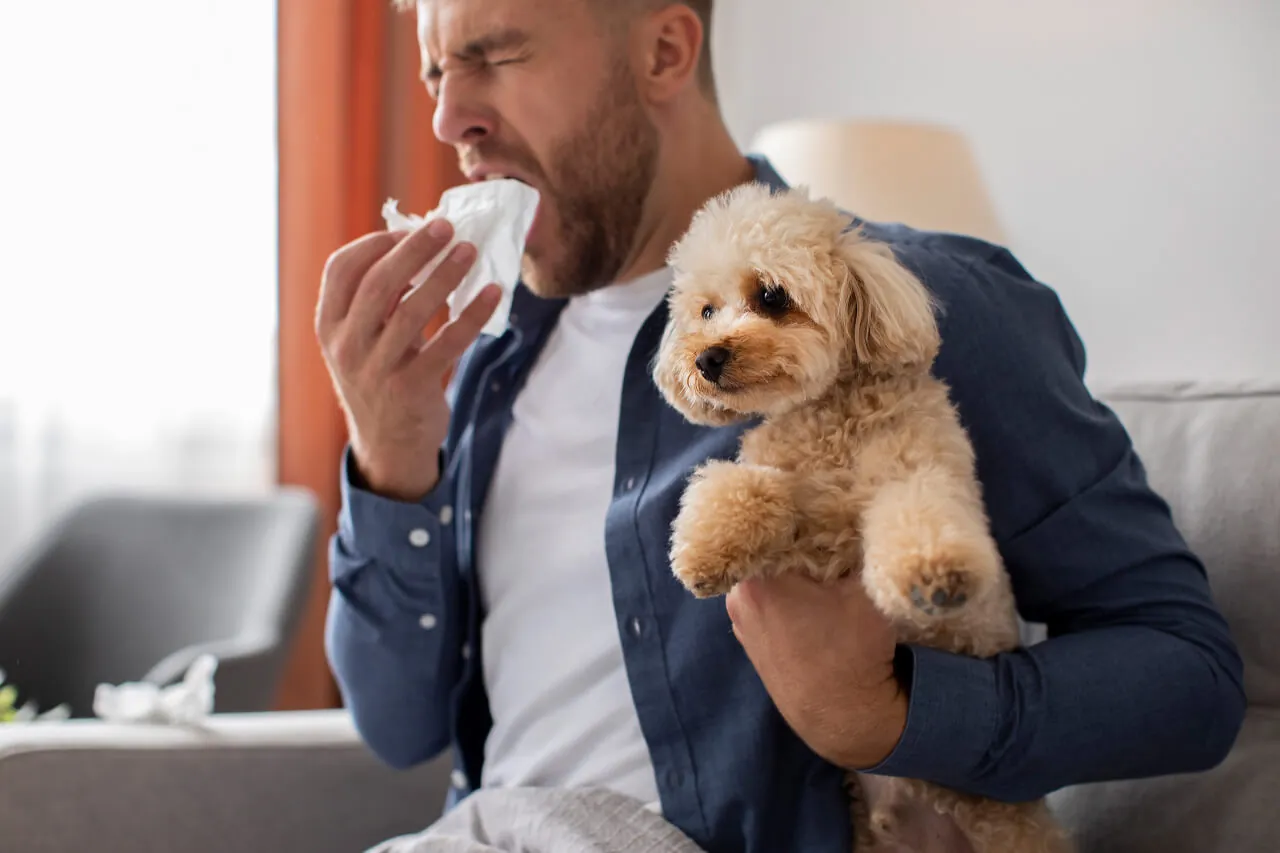A pet allergy is an allergic reaction to proteins found in the skin cells, urine, or saliva of animals, commonly pets such as cats and dogs.
These proteins, known as allergens, can trigger an immune response in some individuals, leading to various allergic symptoms.
Pet allergies can vary in severity, and some individuals may be more sensitive to certain animals than others.
Symptoms of pet allergies can be triggered by contact with surfaces or airborne particles that have come into contact with pet allergens.
Symptoms of Pet Allergies
Pet allergies can manifest with a variety of symptoms, and the severity of these symptoms can vary among individuals.
Common symptoms of pet allergies include:
Sneezing
Exposure to pet allergens can lead to irritation of the nasal passages, triggering sneezing.
Runny or stuffy nose
Allergic reactions can cause an increase in nasal secretions or congestion.
Itchy or watery eyes
Eyes may become red, itchy, and watery due to exposure to pet allergens.
Skin reactions
Some individuals with pet allergies may develop skin symptoms, such as redness, itching, or hives, upon contact with pet allergens.
Coughing and wheezing
Pet allergies can affect the respiratory system, leading to coughing or wheezing.
This can be particularly problematic for individuals with asthma.
Chest tightness
People with asthma or respiratory conditions may experience a feeling of tightness in the chest.
Shortness of breath
In severe cases, exposure to pet allergens can cause difficulty breathing, especially in individuals with asthma.
It’s important to note that these symptoms can occur shortly after exposure to pet allergens, and they may persist as long as the individual is in contact with the allergens.
The Struggle
Suffering from a pet allergies while also loving animals can be a challenging and emotionally conflicted experience.
Here are some aspects of the struggle that someone in this situation might face:
Desire for Companionship
Individuals who love pets often desire the companionship and joy that comes from having a furry friend.
However, the presence of pet allergens can make it difficult to maintain this companionship without triggering allergic reactions.
Emotional Connection to Pets
Pet lovers often form deep emotional bonds with animals.
The inability to be in close contact with pets due to pet allergies may lead to feelings of sadness, frustration, or a sense of missing out on the emotional benefits of pet ownership.
Social Challenges
Pet allergies can impact social interactions, especially in environments where pets are present.
Visiting friends or family with pets, or even spending time in public spaces where animals may be present, can become stressful and uncomfortable.
Guilt and Emotional Strain
The conflict between the desire to have a pet and the reality of pet allergies can create a sense of guilt.
Individuals may feel torn between their love for animals and the need to prioritize their health and well-being.
Practical Limitations
Managing a pet allergy involves practical challenges such as maintaining a clean-living environment, using air purifiers, and taking medications.
These efforts may help reduce symptoms but do not entirely eliminate the risk of allergic reactions.
Treatment Balancing Act
Pursuing treatments like allergy shots (immunotherapy) may be an option, but it requires a significant time commitment and may not be a guaranteed solution.
Balancing the potential benefits of treatment with the ongoing challenges of living with a pet allergy can be a complex decision.
Impact on Mental Health
The constant struggle with pet allergies can contribute to stress and anxiety, impacting one’s overall mental well-being.
The emotional toll of managing allergic reactions may add an extra layer of difficulty to daily life.
Despite these challenges, it’s important to note that many people successfully manage pet allergies and lead fulfilling lives.
Managing pet allergies while still enjoying the companionship of animals requires careful planning and adherence to certain practices.
Here are five steps to help someone keep pets despite having allergies
Choose Hypoallergenic Breeds
Choosing hypoallergenic breeds is one of the key strategies for individuals who want to keep pets despite having allergies.
Hypoallergenic breeds are those that produce fewer allergens, such as dander, saliva, and urine.
Here’s how choosing hypoallergenic breeds can help:
Reduced Allergen Production
Hypoallergenic breeds are known to produce fewer allergens compared to other breeds.
This can be beneficial for individuals with allergies, as it decreases the likelihood of triggering allergic reactions.
Less Shedding of Dander
Dander, which consists of tiny, often microscopic, flecks of skin shed by cats, dogs, and other animals with fur or feathers, is a common allergen.
Hypoallergenic breeds tend to shed less dander, making them a better choice for individuals sensitive to these particles.
Lower Allergenic Saliva and Urine
Allergens are also present in the saliva and urine of pets.
Hypoallergenic breeds often produce fewer allergens in these bodily fluids, reducing the overall allergen load in the home environment.
Less Irritating Hair and Fur
The type of hair or fur a pet has can influence its allergenicity. Some hypoallergenic breeds have hair that is less prone to matting and tangling, making grooming and maintenance easier.
This can result in fewer opportunities for allergens to be released into the environment.
Options for Allergic Individuals
For individuals with known pet allergies, choosing a hypoallergenic breed provides an opportunity to enjoy the companionship of a pet without exacerbating allergic symptoms.
It expands the range of options for pet ownership and increases the likelihood of finding a compatible and allergy-friendly companion.
Consultation with Breeders or Shelters
When considering a hypoallergenic breed, individuals can consult with reputable breeders or visit animal shelters specializing in specific breeds.
Breeders with experience in hypoallergenic breeds can provide information about the characteristics of the breed and help match individuals with pets that may be suitable for their allergy sensitivities.
Create an Allergy-Friendly Living Environment
Creating an allergy-friendly living environment is crucial for individuals who want to keep pets despite having allergies.
This involves implementing measures to minimize exposure to pet allergens in the home.
Here’s how creating an allergy-friendly living environment can help:
Designate Pet-Free Zones
Establish specific areas within the home where pets are not allowed, especially in bedrooms and other areas where the allergic individual spends a significant amount of time.
This helps create “safe” spaces that are less likely to contain high levels of allergens.
Use High-Efficiency Particulate Air (HEPA) Filters
Install HEPA filters in the home’s heating and cooling systems to capture airborne pet allergens.
HEPA filters can trap tiny particles like pet dander and prevent them from circulating in the air.
Regular Cleaning and Vacuuming
Clean the home regularly to reduce the buildup of pet allergens on surfaces.
Use a vacuum cleaner equipped with a HEPA filter to effectively remove allergens from carpets, rugs, and upholstery.
Dusting surfaces and using damp cloths can help capture and remove allergens instead of dispersing them into the air.
Choose Allergen-Resistant Furnishings
Select furniture and bedding that is easy to clean and less likely to trap allergens.
Consider using materials that do not harbor pet dander, such as leather or vinyl, and use allergen-proof covers on mattresses and pillows.
Air Purifiers
Use air purifiers equipped with HEPA filters in key areas of the home to further reduce airborne pet allergens.
Air purifiers can be particularly helpful in bedrooms and other rooms where the allergic individual spends a significant amount of time.
Wash Hands and Clothing
Encourage regular handwashing, especially after handling pets.
This helps prevent the transfer of allergens from hands to the face, reducing the risk of allergic reactions.
Change clothing after prolonged contact with pets, and avoid bringing pet-contaminated clothing into the bedroom.
Creating an allergy-friendly living environment is a holistic approach that, when combined with other strategies such as choosing hypoallergenic breeds, can significantly reduce the impact of pet allergens on individuals with allergies.
Regular maintenance and consistency in implementing these measures are key to the success of managing pet allergies in a home with pets.
Groom and Bathe Pets Regularly
Grooming and bathing pets regularly is an important practice for individuals who want to keep pets despite having allergies.
This routine helps reduce the number of allergens that pets produce, especially in the form of dander.
Here’s how grooming and bathing pets can contribute to managing allergies:
Reduced Dander Production
Regular grooming, including brushing, helps remove loose fur and reduces the amount of dander (tiny flecks of skin) that pets shed. This is particularly important for individuals with pet allergies, as dander is a common allergen.
Minimized Hair and Fur Accumulation
Brushing pets helps prevent the accumulation of loose hair and fur around the home. This reduces the overall allergen load in the environment and minimizes the chances of allergic reactions.
Improved Coat and Skin Health
Regular grooming promotes a healthy coat and skin for pets. This not only enhances their overall well-being but also reduces the likelihood of excessive shedding and dander production.
Outdoor Grooming to Minimize Indoor Allergens
Whenever possible, groom pets outdoors to prevent allergens from spreading inside the home. This is particularly important during shedding seasons when pets may release more dander.
Use of Allergen-Reducing Shampoos
Choose pet shampoos specifically formulated to reduce allergens. These shampoos can help wash away dander and other allergens from the pet’s fur, further minimizing the risk of allergic reactions.
Consultation with a Veterinarian
Consult with a veterinarian for guidance on the best grooming practices for specific breeds and individual pets. Veterinarians can recommend appropriate grooming tools, techniques, and products to minimize allergen production.
Establishing a Routine
Create a regular grooming routine based on the specific needs of the pet. Consistency is key to maintaining a clean and allergen-reduced environment.
Bathing Frequency
While the frequency of bathing may vary depending on the pet’s breed and individual needs, regular baths can help remove allergens from the fur and skin. Consult with a veterinarian to determine an appropriate bathing schedule.
Use of Pet Wipes
In between baths, use pet wipes to clean the pet’s fur and remove surface allergens. This can be especially useful for individuals with allergies who want to minimize contact with dander.
Protective Measures for Groomers
If possible, have a non-allergic household member or a professional groomer handle the grooming process. If the allergic individual is involved, wearing a mask and protective clothing can help minimize direct contact with allergens.
Regular grooming and bathing practices, combined with other allergy management strategies, contribute to creating a more allergy-friendly environment for individuals who want to keep pets. These practices not only benefit the allergic individual but also contribute to the overall well-being and hygiene of the pets.
Implement Personal Hygiene Practices
Implementing personal hygiene practices is crucial for individuals who want to keep pets despite having allergies.
These practices focus on reducing the likelihood of coming into direct contact with pet allergens and minimizing the risk of allergic reactions.
Here’s how personal hygiene practices can help:
Handwashing
Wash hands thoroughly with soap and water immediately after handling pets.
This helps remove allergens from the skin and prevents the transfer of allergens from hands to the face, particularly the eyes, nose, and mouth.
Avoiding Face Touching
Refrain from touching the face, especially the eyes, nose, and mouth, after handling pets.
This reduces the risk of introducing allergens into sensitive areas and triggering allergic reactions.
Changing Clothing
Change clothing after spending extended periods with pets, especially if there has been close contact.
This helps prevent the transfer of allergens from clothing to the living environment.
Use of Protective Clothing
Consider wearing protective clothing, such as long sleeves and pants, to minimize direct contact with pet fur and dander.
This can be particularly helpful during grooming or cleaning activities.
Mask Usage
Wear a mask, particularly when engaged in activities that may generate airborne allergens, such as grooming or cleaning.
Masks can help filter out particles and reduce the inhalation of allergens.
Eye Protection
If eye irritation is a common symptom, consider wearing protective eyewear, such as goggles, during activities that involve close contact with pets or cleaning areas where allergens may be present.
Establishing Entry and Exit Protocols
Designate specific entry and exit points for interacting with pets.
This can help contain allergens to certain areas of the home, making it easier to manage and reduce exposure.
Petting with Caution
Be mindful of where and how pets are petted.
Avoid touching the face immediately after petting, and wash hands promptly.
This reduces the likelihood of transferring allergens to sensitive areas.
Education and Communication
Educate family members and visitors about personal hygiene practices to minimize the spread of pet allergens.
Clear communication is essential to maintaining a cooperative and allergy-friendly living environment.
These personal hygiene practices, when consistently applied, contribute to reducing the direct contact with pet allergens and minimizing the risk of allergic reactions.
When combined with other strategies, such as creating an allergy-friendly living environment and grooming pets regularly, individuals with pet allergies can increase their chances of successfully keeping pets while managing their allergic symptoms.
Consult with Healthcare Professionals
Consulting with healthcare professionals is a crucial step for individuals who want to keep pets despite having allergies.
Healthcare professionals, particularly allergists and immunologists, can provide guidance, conduct tests, and recommend personalized strategies to manage and mitigate allergic reactions.
Here’s how consulting with healthcare professionals can help:
Allergy Testing
Healthcare professionals can conduct allergy tests, such as skin prick tests or blood tests, to identify specific allergens that trigger allergic reactions.
This includes determining whether the individual is specifically allergic to pet dander or other environmental allergens.
Customized Treatment Plans
Based on the results of allergy testing, healthcare professionals can develop personalized treatment plans.
These plans may include medications to alleviate symptoms, lifestyle modifications, and strategies for reducing exposure to allergens.
Medication Management
Healthcare professionals can prescribe medications such as antihistamines, nasal corticosteroids, and decongestants to help manage allergic symptoms.
These medications can be important components of an overall strategy for individuals with pet allergies.
Immunotherapy (Allergy Shots)
For individuals with persistent and severe pet allergies, healthcare professionals may recommend immunotherapy, commonly known as allergy shots.
This involves administering gradually increasing doses of allergens, including those from pets, to help desensitize the immune system over time.
Education on Allergen Avoidance
Healthcare professionals can provide guidance on effective allergen avoidance strategies.
This may include recommendations on creating pet-free zones in the home, using air purifiers, and maintaining a clean-living environment.
Monitoring and Adjusting Treatment Plans
Regular follow-up appointments with healthcare professionals allow for the monitoring of symptoms and the adjustment of treatment plans as needed.
This ongoing collaboration is important for optimizing allergy management strategies.
Advice on Pet Selection
Healthcare professionals can offer advice on selecting pets that are less likely to trigger allergic reactions.
This may include information on hypoallergenic breeds or other factors that can influence the likelihood of an allergic response.
Emergency Preparedness
In severe cases, healthcare professionals can provide guidance on emergency preparedness in the event of a severe allergic reaction, such as anaphylaxis.
This may involve prescribing and teaching the use of epinephrine auto-injectors.
Psychological Support
Living with pet allergies can be emotionally challenging.
Healthcare professionals can offer psychological support and coping strategies to help individuals navigate the emotional aspects of managing allergies while keeping pets.
Integration with Primary Care
Collaborating with primary care providers ensures that the management of pet allergies is integrated into overall healthcare.
This includes addressing any other health conditions that may impact allergic symptoms.
Consulting with healthcare professionals is a comprehensive approach to managing pet allergies.
It involves not only identifying and treating symptoms but also providing guidance on lifestyle adjustments and strategies that allow individuals to enjoy the companionship of pets while minimizing the impact of allergens on their health.
Conclusion
Managing pet allergies while maintaining a loving relationship with animals requires a multifaceted approach that encompasses various strategies.
Choosing hypoallergenic breeds is a practical step toward reducing allergen exposure, as these breeds tend to produce fewer allergens in their dander, saliva, and urine.
Coupled with this, creating an allergy-friendly living environment plays a crucial role in preventing pet allergies.
Designating pet-free zones, using HEPA filters, and implementing regular cleaning routines contribute to minimizing the presence of pet allergens within the home.
Regular grooming and bathing of pets are essential practices for reducing pet allergies production.
By brushing pets regularly and using allergen-reducing shampoos, individuals can mitigate the shedding of dander and maintain a cleaner living space.
Additionally, personal hygiene practices play a pivotal role in preventing direct contact with allergens.
Handwashing, changing clothing, and using protective measures like masks and goggles help individuals minimize the risk of allergic reactions.
Consulting with healthcare professionals is a cornerstone in the effective management of pet allergies.
Through allergy testing, healthcare professionals can identify specific allergens triggering reactions and develop personalized treatment plans.
This may include medication management, immunotherapy (allergy shots), and guidance on allergen avoidance.
Regular follow-up appointments allow for ongoing monitoring and adjustments to treatment plans, ensuring optimal allergy management.
Despite the challenges, these collective efforts empower individuals to keep pets while navigating the complexities of pet allergies.
With a commitment to hygiene, a tailored healthcare plan, and lifestyle adjustments, individuals can enjoy the companionship of their pets without compromising their health.
FAQs
Can I keep pets if I have pet allergies?
Yes, choosing hypoallergenic breeds and implementing allergy-friendly practices can help reduce allergen exposure, allowing many individuals with allergies to enjoy pet companionship.
What are hypoallergenic breeds?
Hypoallergenic breeds produce fewer allergens in their dander, saliva, and urine. Examples include poodles, bichon frises, and certain terriers.
How can I create an allergy-friendly living environment if i have pet allergies?
Designate pet-free zones, use HEPA filters, and maintain a clean home through regular vacuuming and dusting to minimize allergen presence.
What if I experience severe allergic reactions?
In severe cases, healthcare professionals can provide emergency preparedness guidance, including the prescription and instruction on using epinephrine auto-injectors.





